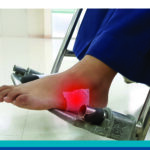
Diabetes and Hard-to-Heal Wounds – Lake Charles Memorial Health System Offers Options
November 2024
The Impact of Diabetes on Eye Health
November 2024by Kristy Como Armand
Foot problems are a well-known risk associated with diabetes and the reality of the risks is quite serious. Diabetes is the number one cause of lower limb amputations in the United States, with over half of amputations performed caused by the disease.
Diabetes can cause reduced blood flow to the feet, depriving them of oxygen and nutrients. This makes it more difficult for blisters, sores, and cuts to heal. Diabetic nerve damage called peripheral neuropathy can cause numbness in your feet. “When you can’t feel cuts and blisters, you’re more likely to get sores and infections,” explains Dr. Tyson Green, foot and ankle specialist with the Center for Orthopaedics and medical director of CHRISTUS Wound Center. “If you don’t notice or treat these sores, they can become deeply infected. This is what typically leads to amputation. Unfortunately, having a toe, foot, or lower leg surgically removed is 10 times more likely in people with diabetes.”
As frightening as this sounds, Dr. Green stresses that serious foot problems are not an inevitable part of having diabetes. “At least half of the amputations related to diabetes each year could be prevented through proper care of the feet – and that’s a conservative estimate. The key is learning about the risks for foot problems and making sure you do everything you need to do to prevent these potential complications.”
Dr. Green offers the following tips for putting your feet first:
Check feet daily. Look at your feet every day to check for cuts, sores, blisters, redness, calluses, or other problems. This is even more important if you have nerve damage or poor blood flow. Check between all of your toes because blisters and infections can start there, and if you have diabetic neuropathy, you may not feel them until they’ve become irritated or infected.
Wash with warm water. Wash both feet briefly each day with warm water. Make sure the water is not too hot by testing the temperature with your elbow. Do not soak your feet, and dry your feet well, especially between your toes.
Ensure shoes fit well. If you have diabetes, good shoes are an investment worth making. Even the slightest tightness or rubbing in the wrong place can cause a blister that could turn into a sore that won’t heal. Shop for shoes at the end of the day when your feet are bigger, and before buying or putting on shoes, check inside for rough edges or other irregularities that could hurt your feet. Break new shoes in gradually by wearing them for short periods of time – an hour or two a day to make sure they don’t cause problems.
No bare feet. Always wear shoes or slippers, and always wear socks with your shoes. Direct contact with leather, plastics, and manmade shoe materials can irritate your skin and quickly bring on blisters. And although you might prefer the look of hose or thin socks, these don’t give your toes or heels enough protection.
Stay soft – but dry. High glucose levels can cause dry and cracked skin – this means double trouble for the feet. It makes it easier for bacteria to get under the skin, and harder for infections to heal. Use a small amount of skin lotion daily and rub it in well. Feet should be dry, not damp or sticky, and you don’t want lotion in between your toes.
Practice foot maintenance. File corns and calluses gently with an emery board or pumice stone after your bath or shower, when skin is softer. Keep toenails trimmed and filed smooth to avoid ingrown toenails. Cut nails to the shape of the toe and not too short, and file the edges with an emery board.
Fix problems. Bunions (the big toe slants sharply in toward your other toes, with a big bump on the knuckle of your big toe), corns (spots of thick, rough skin on the toes), or conditions that make it difficult for shoes to fit properly can lead to blisters and other problems.
Dr. Green says the underlying message of all these recommendations is to be extra vigilant about your feet if you have diabetes. “It’s also important to talk to your doctor if you have any concerns, regardless of how minor they may seem. Tell them about any changes in sensation in your toes, feet, or legs. It’s better to be overly cautious than to ignore a symptom that could be a sign of a serious problem. That said, serious foot problems are not an inevitable part of having diabetes. Awareness of the risk is critical, along with proper foot care.”
For more information about diabetes and foot care, call Dr. Green at the Center for Orthopaedics, (337) 721-7236, or visit www.centerforortho.com.
Stay on your Toes when Shopping for Shoes
If you have diabetes, choosing the right shoes is important. Dr. Green offers the following shoe shopping suggestions to ensure a good fit and minimize the risk of complications:
Spacious toe box: The area around the toes should be wide and not constrictive.
Wide foot bed and deep interior: This allows for foot swelling during the day. A spacious interior provides room for cushioning inserts.
Breathable material: Bacteria and infections thrive in warm, damp environments. Leather and many synthetics help deflect moisture.
Insole cushioning: Ample padding minimizes pressure on the foot’s sole.
Adjustable closure – laces or buckle: This accommodates any foot swelling that occurs throughout the day.
Seamless interior: Raised seams can cause friction and irritation.
Closed design: This keeps debris out, which can be tough to detect if you have decreased sensation in your feet.
Hard outsole: Hard rubber soles protect your feet from sharp objects.
Low heel: High heels create pressure points on the balls and heels of the feet that can lead to calluses and ulcers. Wide, square heels less than 1-2 inches in height are best.






